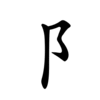阝
| ||||||||
Translingual
| Stroke order | |||
|---|---|---|---|
 | |||
Han character
阝 (radical 170, 阜+0, 3 strokes in traditional Chinese, Japanese and Korean, 2 strokes in mainland China, cangjie input 弓中 (NL) or XX弓中 (XXNL), four-corner 77227, composition ⿰丨㇌)
Derived characters
- Index:Chinese radical/阜 (as left radical)
- Index:Chinese radical/邑 (as right radical)
References
- KangXi: page 1345, character 4
- Dai Kanwa Jiten: character 41536
- Dae Jaweon: page 1847, character 27
- Hanyu Da Zidian: volume 6, page 4114, character 3
- Unihan data for U+961D
Chinese
| simp. and trad. |
阝 | |
|---|---|---|
Etymology 1
Pronunciation
Synonyms
- 左耳刀 (zuǒ'ěrdāo)
Etymology 2
Pronunciation
Synonyms
- 右耳刀 (yòu'ěrdāo)
Japanese
Kanji
阝
- This term needs a translation to English. Please help out and add a translation, then remove the text
{{rfdef}}.
Korean
Hanja
阝 • (bu) (hangeul 부, revised bu, McCune–Reischauer pu, Yale pu)
- This term needs a translation to English. Please help out and add a translation, then remove the text
{{rfdef}}.
Vietnamese
Han character
- This term needs a translation to English. Please help out and add a translation, then remove the text
{{rfdef}}.
References
This article is issued from
Wiktionary.
The text is licensed under Creative
Commons - Attribution - Sharealike.
Additional terms may apply for the media files.